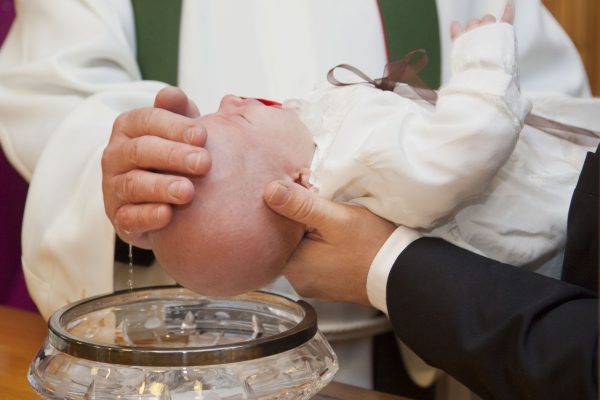Home>Theology and Spirituality>What Is Emergency Baptism? When And How Is It Administered?


Theology and Spirituality
What Is Emergency Baptism? When And How Is It Administered?
Published: February 26, 2024
Ericka Andersen, an editor at Christian.net, expertly merges digital strategy with content creation, focusing on faith and societal issues. Her communication skills enhance the platform's engaging narratives, fostering meaningful dialogue on belief's impact on society.
Learn about emergency baptism in theology and spirituality. Discover when and how it is administered in the Christian faith.
(Many of the links in this article redirect to a specific reviewed product. Your purchase of these products through affiliate links helps to generate commission for Christian.net, at no extra cost. Learn more)
Table of Contents
Understanding Emergency Baptism
Emergency baptism, also known as baptism of necessity, is a sacrament of the Catholic Church that is administered in cases of urgent necessity. It is a way of cleansing the soul and welcoming an individual into the faith when there is a risk of death. This form of baptism is considered valid and efficacious, even if it is performed by a person who is not a priest or deacon. The belief in emergency baptism stems from the understanding that baptism is necessary for salvation, and in emergency situations, it is crucial to ensure that the individual's soul is prepared for the afterlife.
Emergency baptism is a significant aspect of the Catholic faith, as it reflects the Church's commitment to ensuring that all individuals have the opportunity to receive the grace of baptism, regardless of the circumstances. It is a demonstration of the Church's belief in the importance of baptism for the salvation of the soul, and it emphasizes the idea that no one should be deprived of this opportunity, even in the face of imminent danger or uncertainty.
The sacrament of emergency baptism is rooted in the belief that baptism is essential for the forgiveness of sins and the reception of the Holy Spirit. It is a rite of initiation into the Christian faith and is believed to cleanse the individual of original sin, as well as any personal sins that may have been committed. In emergency situations, the urgency of the need for baptism takes precedence over the usual requirements for the administration of the sacrament, allowing for flexibility in its application.
Emergency baptism is a solemn and sacred ritual that is performed with the utmost care and reverence, even in the midst of a crisis. It is a testament to the Church's dedication to upholding the spiritual well-being of its members, especially in times of distress and uncertainty. The administration of emergency baptism is a profound expression of the Church's commitment to ensuring that individuals have the opportunity to receive the grace of baptism, regardless of the circumstances they may face.
Read more: Who Can Administer The Sacrament Of Baptism
The Importance of Emergency Baptism
-
Salvation: Emergency baptism is of utmost importance as it is believed to be essential for the salvation of the soul. In the Catholic faith, baptism is considered the gateway to the other sacraments and is necessary for entering the kingdom of heaven. Therefore, in situations where there is a risk of death, the administration of emergency baptism ensures that the individual's soul is prepared for the afterlife.
-
Cleansing of Sin: Another crucial aspect of emergency baptism is its role in cleansing the individual of sin. It is believed to wash away original sin and any personal sins that may have been committed. This cleansing is vital for the spiritual well-being of the individual, especially in urgent situations where the usual process of baptism cannot be followed.
-
Reception of the Holy Spirit: Baptism, including emergency baptism, is seen as the means through which an individual receives the Holy Spirit. This reception is essential for the individual's spiritual growth and connection to the divine. In emergency situations, the importance of facilitating this connection becomes even more pronounced, highlighting the significance of emergency baptism.
-
Inclusivity: Emergency baptism underscores the inclusive nature of the Catholic Church. It demonstrates the Church's commitment to ensuring that all individuals, regardless of their circumstances, have the opportunity to receive the grace of baptism. This inclusivity reflects the Church's belief in the universal need for spiritual nourishment and salvation, regardless of the challenges individuals may face.
-
Spiritual Well-being: The administration of emergency baptism is a testament to the Church's dedication to upholding the spiritual well-being of its members, particularly in times of distress and uncertainty. It serves as a source of comfort and assurance, both for the individual receiving the sacrament and for their loved ones, knowing that their spiritual needs are being attended to, even in the face of an emergency.
-
Flexibility and Compassion: Emergency baptism also highlights the flexibility and compassion within the Catholic Church. It acknowledges that in urgent situations, the traditional protocols for administering sacraments may not be feasible, and thus allows for a more flexible approach to ensure that the spiritual needs of the individual are met, emphasizing the compassionate nature of the Church.
-
Preparation for Community: Lastly, emergency baptism is important as it prepares the individual to become a part of the Christian community. It signifies their initiation into the faith and their acceptance into the broader community of believers, regardless of the circumstances under which the sacrament is administered.
In summary, the importance of emergency baptism lies in its role in ensuring the spiritual well-being, salvation, and inclusion of individuals, even in the most urgent and challenging situations.
When Emergency Baptism Is Administered
-
Imminent Danger of Death: Emergency baptism is administered when an individual is in imminent danger of death. This could arise from various situations such as severe illness, injury, or any other circumstance where there is a genuine risk to the person's life. In such critical moments, the urgency of ensuring the individual's spiritual well-being takes precedence, leading to the administration of emergency baptism.
-
Lack of Access to a Priest or Deacon: Another scenario in which emergency baptism is administered is when there is no access to a priest or deacon who can perform the sacrament in the traditional manner. This could occur in remote or isolated areas, during natural disasters, or in other situations where the presence of clergy is not feasible. In such cases, individuals present at the scene may be called upon to administer emergency baptism.
-
Desire for Baptism: Emergency baptism may also be administered when there is a genuine desire for baptism, and the usual process cannot be followed due to unforeseen circumstances. This could include situations where an individual expresses a fervent wish to be baptized, but time constraints or other factors prevent the standard procedure from being carried out. In such cases, emergency baptism allows for the fulfillment of this spiritual longing.
-
Unconsciousness or Incapacity: In instances where an individual is unconscious or incapacitated and unable to express their desire for baptism, emergency baptism may be administered based on the belief that the person would have desired it if they were able to communicate. This is done with the intention of ensuring the individual's spiritual well-being, even in their incapacitated state.
-
Sudden Onset of Labor: Emergency baptism is also administered in cases where a newborn is in danger of death shortly after birth. If a child is born and is in critical condition, emergency baptism may be performed to ensure the child's reception of the sacrament in the face of potential danger to their life.
-
Unforeseen Emergencies: Additionally, emergency baptism may be administered in unforeseen emergencies where the usual process of baptism cannot be followed due to time constraints, impending danger, or other critical factors. The flexibility of emergency baptism allows for the accommodation of such unforeseen circumstances, ensuring that the spiritual needs of the individual are addressed without delay.
In summary, emergency baptism is administered in situations of imminent danger, lack of access to clergy, genuine desire for baptism, unconsciousness or incapacity, critical conditions shortly after birth, and unforeseen emergencies where the standard process of baptism cannot be followed.
How Emergency Baptism Is Administered
-
Use of Water: The administration of emergency baptism involves the use of water. If possible, the water should be poured over the individual's head while the minister of the sacrament (who could be any baptized person) says, "I baptize you in the name of the Father, and of the Son, and of the Holy Spirit." The pouring of water symbolizes the cleansing and rebirth associated with baptism, while the Trinitarian formula reflects the invocation of the divine presence.
-
Intention and Belief: The individual administering emergency baptism must have the intention to perform the sacrament and must do so with the belief in its spiritual significance. The sincerity and reverence with which the sacrament is administered reflect the understanding of its importance and the commitment to ensuring the individual's spiritual well-being.
-
Inclusion of Witnesses: While not a strict requirement, the inclusion of witnesses, if possible, can serve as a means of affirming the administration of emergency baptism. Witnesses can attest to the circumstances under which the sacrament was performed, providing additional assurance of its validity and the genuine need for its administration.
-
Prayer and Invocation: Alongside the pouring of water and the verbal declaration, the minister of the sacrament may offer prayers for the individual's well-being and safety. This act of prayer reflects the compassionate and caring nature of the sacrament, emphasizing the spiritual support and guidance sought for the individual in their time of need.
-
Record Keeping: It is advisable, if feasible, to make a record of the emergency baptism, including the date, location, and the names of the individual, the minister, and any witnesses present. This record serves as a testament to the administration of the sacrament and can provide reassurance to the individual and their community regarding the spiritual care extended to them.
-
Follow-Up with the Church: After the administration of emergency baptism, efforts should be made to inform the local parish or diocese about the sacrament that was performed. This allows for the sacrament to be officially recognized and recorded within the Church's records, ensuring that the individual's initiation into the faith is acknowledged and supported by the broader religious community.
In essence, the administration of emergency baptism involves the use of water, the intention and belief of the minister, the potential inclusion of witnesses, the offering of prayers, record-keeping, and follow-up with the Church to ensure the sacrament is duly recognized.















